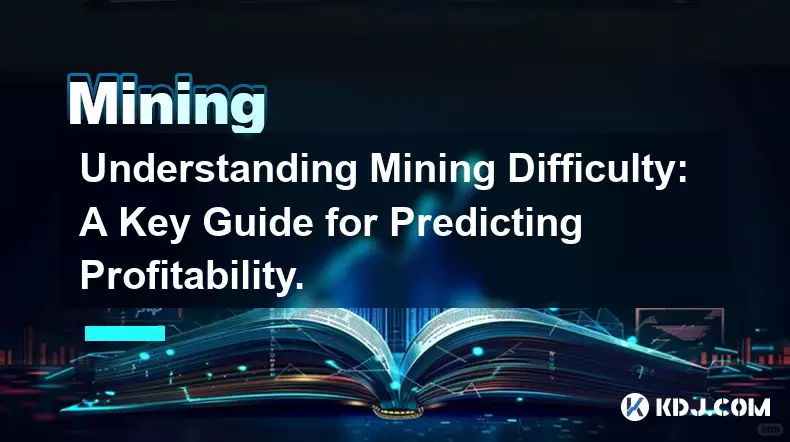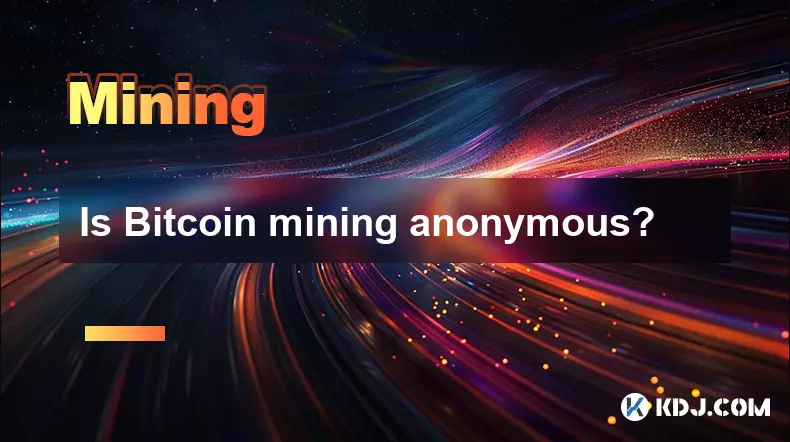-
 bitcoin
bitcoin $99177.955738 USD
-7.32% -
 ethereum
ethereum $3187.183061 USD
-12.38% -
 tether
tether $0.999809 USD
0.00% -
 xrp
xrp $2.117933 USD
-9.42% -
 bnb
bnb $906.710033 USD
-9.17% -
 solana
solana $149.367737 USD
-10.74% -
 usd-coin
usd-coin $0.999816 USD
0.01% -
 tron
tron $0.281498 USD
-0.38% -
 dogecoin
dogecoin $0.156292 USD
-8.00% -
 cardano
cardano $0.500744 USD
-10.19% -
 hyperliquid
hyperliquid $38.087358 USD
-4.58% -
 chainlink
chainlink $14.097831 USD
-8.54% -
 bitcoin-cash
bitcoin-cash $463.329916 USD
-9.22% -
 ethena-usde
ethena-usde $0.999078 USD
-0.01% -
 unus-sed-leo
unus-sed-leo $9.475862 USD
-0.79%
Understanding Mining Difficulty: A Key Guide for Predicting Profitability.
Mining difficulty adjusts every ~2 weeks in Bitcoin to maintain steady block times, ensuring network stability and controlled coin issuance despite changing computational power.
Nov 05, 2025 at 02:09 pm

What Is Mining Difficulty in Cryptocurrency?
1. Mining difficulty refers to the measure of how hard it is to find a hash below a given target in a blockchain network. This value adjusts periodically to maintain consistent block production times, regardless of how much computational power joins or leaves the network.
2. In networks like Bitcoin, the difficulty level recalibrates approximately every 2016 blocks, which translates to about two weeks based on a ten-minute average block time. This adjustment ensures that even if thousands of new mining rigs come online, the rate at which new blocks are added remains stable.
3. The algorithm compares the actual time taken to mine the previous set of blocks against the expected time. If blocks were mined faster than intended, the difficulty increases; if slower, it decreases. This self-regulating mechanism maintains network integrity and predictable issuance of new coins.
4. A higher difficulty means miners must perform more computational work to solve the cryptographic puzzle required to validate transactions and add a new block. As a result, individual miners or smaller operations may find it increasingly challenging to compete without access to advanced hardware and cheap electricity.
5. Mining difficulty acts as a critical balancing factor that preserves decentralization and prevents inflation by controlling the pace of coin creation, even as technology evolves and more participants enter the space.
How Mining Difficulty Impacts Profitability
1. When mining difficulty rises, each unit of hashing power contributes less frequently to successful block discoveries. This directly reduces potential rewards for miners unless they scale up their operations or improve efficiency.
2. Electricity costs become more significant as difficulty increases. Miners operating in regions with high energy prices may see shrinking margins or even losses when the network becomes more competitive. Efficiency in power usage per terahash becomes a decisive factor in staying profitable.
3. Hardware depreciation accelerates under high difficulty conditions. Older ASIC models that once generated steady returns may no longer cover operational expenses, forcing upgrades to newer, more powerful machines—an investment that can run into thousands of dollars.
4. Pool fees also play a role. Many miners join pools to combine hashing power and receive proportional payouts. However, increased difficulty often leads to higher pool participation, which means more competition internally and reduced net earnings after service charges.
5. Profitability calculators must account for real-time difficulty levels, along with electricity rates, hardware performance, and pool fees, to provide accurate projections of daily or monthly earnings.
Factors That Influence Changes in Mining Difficulty
1. Network hashrate is the primary driver behind difficulty adjustments. When more miners contribute processing power, the collective hashrate climbs, prompting the protocol to raise the difficulty to preserve block timing.
2. Geopolitical events affecting energy policies or crypto regulations can shift mining activity across regions. For example, China’s mining ban in 2021 caused a temporary drop in global hashrate, leading to a downward difficulty adjustment before operations relocated to countries like the U.S. and Kazakhstan.
3. Technological advancements in semiconductor design allow manufacturers to release more efficient mining rigs. Widespread adoption of these devices increases effective hashrate, triggering upward pressure on difficulty even without new miners entering the market.
4. Seasonal energy pricing impacts miner behavior. In colder months, heating demands increase electricity costs in some areas, causing marginal miners to shut down equipment. This reduction in active hashrate can lead to subsequent difficulty decreases.
5. Sudden influxes of institutional mining operations equipped with large-scale data centers significantly alter the hashrate landscape, accelerating difficulty growth and reshaping the competitive environment for retail miners.
Frequently Asked Questions
How often does Bitcoin mining difficulty change?Bitcoin adjusts its mining difficulty approximately every 2016 blocks, which occurs roughly every two weeks. The exact interval depends on how quickly the prior blocks were mined relative to the ten-minute target.
Can mining difficulty decrease?Yes, mining difficulty can go down. If a significant number of miners go offline—due to rising electricity costs, regulatory crackdowns, or technical failures—the network detects slower block production and automatically lowers the difficulty to maintain consistent block intervals.
Does higher mining difficulty mean higher transaction fees?Not directly. Transaction fees are influenced by block space demand, not difficulty itself. However, during periods of high network congestion and elevated difficulty, users may choose to pay higher fees to prioritize their transactions, creating an indirect correlation.
Is it still profitable to mine cryptocurrency when difficulty is high?Profitability under high difficulty depends on several factors: access to low-cost electricity, use of state-of-the-art hardware, geographic location, and the current market price of the mined asset. Some miners remain profitable through vertical integration and renewable energy sources, while others exit the market.
Disclaimer:info@kdj.com
The information provided is not trading advice. kdj.com does not assume any responsibility for any investments made based on the information provided in this article. Cryptocurrencies are highly volatile and it is highly recommended that you invest with caution after thorough research!
If you believe that the content used on this website infringes your copyright, please contact us immediately (info@kdj.com) and we will delete it promptly.
- Germany's Celtic Gold Rush: Metal Detectors Unearth Ancient Treasures
- 2025-11-06 03:00:01
- XRP, Corporate Treasuries, and FX Hedging: A New Era for Global Finance?
- 2025-11-06 02:30:01
- ARC Token: India's Bold Step into Government Securities-Backed Digital Assets
- 2025-11-06 02:45:01
- Trader's Guide: Cryptos to Buy Now for a Smarter 2026
- 2025-11-06 03:30:02
- Solana's Price Recovery: Harmonic Launch and Key Developments
- 2025-11-06 01:05:01
- Nebius Token Factory: Democratizing AI Deployment at Scale
- 2025-11-06 01:35:01
Related knowledge

What is the block reward in mining?
Nov 06,2025 at 12:35am
Understanding Block Rewards in Cryptocurrency Mining1. The block reward is the incentive miners receive for successfully validating and adding a new b...

Does an antivirus program affect mining?
Nov 05,2025 at 09:29pm
Understanding Decentralized Exchanges in the Crypto Ecosystem1. Decentralized exchanges (DEXs) operate without a central authority, allowing users to ...

What is the history of Bitcoin mining?
Nov 05,2025 at 08:15pm
Within the fast-moving world of cryptocurrency, new developments emerge daily, reshaping how investors, developers, and institutions interact with dig...

How is the energy consumption of mining justified?
Nov 05,2025 at 10:20pm
Energy Consumption in Cryptocurrency Mining1. The energy consumption associated with cryptocurrency mining has drawn significant attention from enviro...

What are the main components of a mining rig?
Nov 05,2025 at 08:09pm
Main Components of a Mining Rig1. A mining rig consists of several essential hardware components designed to solve complex cryptographic equations req...

Is Bitcoin mining anonymous?
Nov 06,2025 at 12:15am
Understanding Bitcoin Mining and Privacy1. Bitcoin mining is the process through which new transactions are verified and added to the blockchain. Mine...

What is the block reward in mining?
Nov 06,2025 at 12:35am
Understanding Block Rewards in Cryptocurrency Mining1. The block reward is the incentive miners receive for successfully validating and adding a new b...

Does an antivirus program affect mining?
Nov 05,2025 at 09:29pm
Understanding Decentralized Exchanges in the Crypto Ecosystem1. Decentralized exchanges (DEXs) operate without a central authority, allowing users to ...

What is the history of Bitcoin mining?
Nov 05,2025 at 08:15pm
Within the fast-moving world of cryptocurrency, new developments emerge daily, reshaping how investors, developers, and institutions interact with dig...

How is the energy consumption of mining justified?
Nov 05,2025 at 10:20pm
Energy Consumption in Cryptocurrency Mining1. The energy consumption associated with cryptocurrency mining has drawn significant attention from enviro...

What are the main components of a mining rig?
Nov 05,2025 at 08:09pm
Main Components of a Mining Rig1. A mining rig consists of several essential hardware components designed to solve complex cryptographic equations req...

Is Bitcoin mining anonymous?
Nov 06,2025 at 12:15am
Understanding Bitcoin Mining and Privacy1. Bitcoin mining is the process through which new transactions are verified and added to the blockchain. Mine...
See all articles










































































